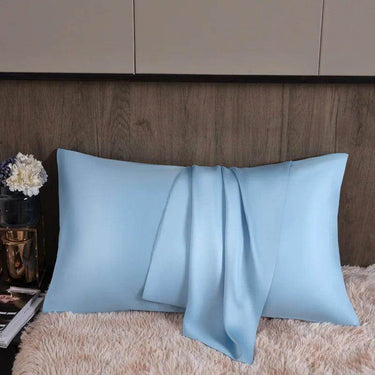How to Wash and Maintain Your Silk Pillowcase: A Complete Care Guide
1. Introduction to Washable Silk Pillowcases
Silk pillowcases transform your sleep experience while providing significant benefits for your skin and hair. The natural proteins in mulberry silk reduce friction, minimizing hair breakage and preventing facial creases that develop into wrinkles over time. This premium fabric also regulates temperature and wicks moisture, creating an optimal sleep environment.
However, maintaining these benefits requires proper care. Washable silk pillowcases combine luxury with practicality, allowing you to preserve their unique properties through regular cleaning. Understanding the correct washing techniques ensures your investment stays pristine for years. This guide walks you through selecting quality silk pillowcases and establishing an effective care routine to maximize their lifespan and performance.

2. Choosing the Right Washable Silk Pillowcase
2.1. Material Quality
When selecting silk pillowcases, material quality determines their performance and durability. Mulberry silk stands as the gold standard among silk varieties. Harvested from silkworms fed exclusively on mulberry leaves, this silk type produces longer, more uniform fibers than its counterparts. These characteristics create a smoother surface that delivers superior benefits for skin and hair care.
The density of silk fabric is measured in momme (mm), similar to thread count in cotton. For pillowcases, 19-22 momme provides the optimal balance between durability and softness. LANI SILK pillowcases feature 22 momme silk, ensuring substantial weight while maintaining breathability. Lower momme counts (below 16) often feel thin and deteriorate quickly with washing, while counts exceeding 25 may sacrifice breathability for density. Choose washable silk with appropriate momme weight to ensure your pillowcase withstands regular cleaning without compromising its therapeutic properties.
2.2. Closure Types and Designs
The closure system on your silk pillowcase affects both its functionality and maintenance requirements. Envelope closures provide a clean, seamless appearance and keep pillows securely encased without zippers that might catch on delicate fabric. This design creates a polished look and prevents pillow exposure during sleep, while offering simplicity in care as there are no hardware components to maintain.
Zipper closures deliver complete security for your pillow with a tailored fit that prevents shifting throughout the night. Quality silk pillowcases like those from LANI SILK feature hidden zippers with protective flaps to prevent contact with your skin and hair. These closures require occasional maintenance to ensure smooth operation, including keeping the teeth free from fabric threads that may cause jamming.
The design elements of your silk pillowcase also impact care requirements. Solid colors show fewer water marks after washing and maintain their appearance longer than patterns or prints, making them practical for long-term use and easier to maintain. Patterned designs require more careful washing to preserve detail and color integrity, often benefiting from hand washing rather than machine cycles to prevent color bleeding or fading.
Decorative elements such as border details like piping or contrasting edges need special attention during washing to maintain their structure and prevent fraying or color bleeding. These embellishments often require gentle hand washing to preserve their dimensional quality and prevent distortion that can occur in machine cycles. Consider these design factors when establishing your pillowcase care routine to preserve both appearance and functionality.

Compare the dense weave structure of 22 momme mulberry silk (right) with standard 16 momme silk (left) - notice the difference in fiber density and smoothness.
3. Washing Your Silk Pillowcase
3.1. Hand Washing
Hand washing remains the safest method for cleaning silk pillowcases, preserving their natural sheen and extending their lifespan. Follow these steps for optimal results:
Begin by filling a clean basin or sink with cool water (65-75°F or 18-24°C). Add a small amount of silk-specific detergent or mild shampoo—approximately one teaspoon per gallon (3.8 liters) of water. Avoid standard laundry detergents, which contain enzymes and brighteners that damage silk fibers. Turn your pillowcase inside out, then submerge it in the solution, gently agitating to distribute the cleanser without rubbing or twisting.
Allow the pillowcase to soak for 3-5 minutes, then drain the soapy water. Rinse thoroughly with cool, clean water until all soap residue disappears. Press the fabric between your palms to remove excess water, avoiding wringing or twisting which distorts the fibers. Roll the damp pillowcase in a clean, white towel to absorb remaining moisture before proceeding to the drying phase.
3.2. Machine Washing
While hand washing remains ideal, machine washing offers convenience for busy lifestyles when performed correctly. Begin by placing your silk pillowcase in a fine mesh laundry bag, which creates a protective barrier between the delicate fabric and the washing machine drum. This simple step prevents the silk from catching on other items or mechanical parts, significantly reducing the risk of snags and tears during the wash cycle.
The machine settings require careful attention to preserve silk quality. Select the delicate or hand wash cycle with cold water (below 86°F or 30°C) to minimize fiber stress and prevent color fading. Most modern washing machines offer specific programs for delicate fabrics that reduce mechanical agitation. Limit the spin speed to 600 RPM or less to reduce creasing and fiber damage that occurs at high centrifugal forces, as excessive spinning stretches and weakens silk proteins.
Detergent selection proves equally important when machine washing silk. Use silk-specific detergent without enzymes, bleach, or optical brighteners that break down protein fibers. These specialized formulations clean effectively while maintaining silk's natural pH balance and structural integrity. Avoid mixing colors during washing to prevent dye transfer, especially with new silk items that may release excess dye during initial cleanings.
Conventional laundry additives can damage silk's natural properties. Skip fabric softeners which coat silk fibers with synthetic chemicals that reduce their moisture-wicking and temperature-regulating abilities. Upon completion of the wash cycle, remove your pillowcase promptly from the machine to prevent set-in wrinkles from developing as the fabric dries in a compressed state. This immediate attention minimizes the need for ironing later and preserves the natural drape of the fabric.

4. Drying and Ironing Silk Pillowcases
4.1. Drying Methods
Air drying preserves silk's natural properties and prevents the fiber damage that machine drying causes. After washing, reshape your silk pillowcase while damp and lay it flat on a clean, white towel in an indoor location away from direct sunlight. UV rays fade colors and weaken silk fibers, even during brief exposure. Position the pillowcase away from heat sources like radiators or vents, as extreme temperature fluctuations cause fibers to contract unevenly.
In humid environments, ensure adequate air circulation to prevent mildew development. If necessary, replace the towel beneath the pillowcase if it becomes saturated with moisture. Allow 4-6 hours for complete drying, though thicker silk (22 momme and above) may require additional time. The pillowcase should feel completely dry to the touch before storing or using, as residual moisture weakens fibers and attracts dust mites.
4.2. Ironing Techniques
Ironing silk pillowcases requires precision to smooth wrinkles without damaging delicate fibers. Set your iron to the lowest heat setting (usually marked "silk" or "low") and ensure the soleplate remains clean of mineral deposits or residue that might transfer to the fabric. Wait until the pillowcase is almost completely dry but retains slight dampness for easier wrinkle removal.
Place a clean cotton pressing cloth or thin cotton handkerchief over the silk to create a protective barrier between the iron and your pillowcase. Working from the reverse side, move the iron in smooth, continuous motions rather than pressing down in one spot. Keep the iron moving to prevent heat concentration that causes scorching. Focus on one small section at a time, gradually working across the entire surface. Allow the pillowcase to cool completely before placing it on your pillow to prevent new wrinkles from forming.

5. Maintaining and Extending the Life of Silk Pillowcases
5.1. Regular Washing Frequency
Washing silk pillowcases weekly maintains hygiene without excessive wear on the fabric. During sleep, your skin transfers oils, dead cells, and skincare products to the pillowcase surface, creating an environment where bacteria thrive. Regular washing removes these accumulations before they penetrate deeply into silk fibers, preventing potential staining and fiber degradation.
For those with sensitive skin or acne-prone complexions, washing every 3-4 days proves beneficial for skin clarity. During summer months or in humid climates, increase washing frequency to address increased perspiration that impacts both the silk's performance and your skin health. Establish a consistent rotation system with multiple pillowcases to reduce washing frequency for each individual piece while maintaining hygiene. This rotation system distributes wear evenly across your collection, extending the overall lifespan of your silk investment.
5.2. Stain Removal and Prevention
Effective stain management combines swift action with appropriate techniques to preserve silk integrity. When spills or marks occur, treat stains immediately by blotting (never rubbing) with a clean, white cloth to absorb excess liquid before it penetrates fibers. This immediate response prevents liquids from bonding with silk proteins, which makes subsequent removal significantly more difficult. For stubborn marks that persist despite blotting, create a mild solution using one part white vinegar to ten parts cool water for protein-based stains like sweat or skincare products. This gentle acidic mixture breaks down protein bonds without damaging the silk's natural structure.
Before applying any stain treatment to visible areas, test the solution on an inconspicuous corner first to ensure colorfastness. Even mild cleaners can affect dyes differently depending on fabric processing and color compounds. This precautionary step prevents potential color damage that would be more noticeable than the original stain. When treating stains, work from the outside inward using light dabbing motions to prevent spreading the mark to clean areas.
Prevention strategies significantly reduce stain frequency and severity. Apply night skincare routines at least 20 minutes before bed, allowing products to absorb into skin rather than transferring to silk. This waiting period ensures serums, moisturizers, and treatments penetrate the skin fully instead of creating oily deposits on your pillowcase. Style hair with silk-friendly products that won't leave residue or cause discoloration when they contact your pillowcase, avoiding formulations containing alcohol or heavy polymers that can degrade silk fibers.
Water quality impacts both stain removal effectiveness and general cleaning results. Use distilled water for cleaning when possible, as minerals in tap water can leave deposits on silk that dull its appearance over repeated washings. These mineral deposits accumulate gradually, creating a film that diminishes silk's natural luster. Additionally, take care to avoid contact with acne medications containing benzoyl peroxide, which permanently bleaches silk fibers on contact through an oxidation process that cannot be reversed, even with professional cleaning.

6. Common Issues and Solutions
6.1. Color Fading and Snagging
Color preservation requires preventative measures throughout the silk pillowcase lifecycle. Store pillowcases in drawers lined with acid-free tissue paper and away from direct sunlight, which breaks down both dyes and fibers. During washing, turn pillowcases inside out to protect the visible surface from friction and abrasion. Add one tablespoon (15 ml) of white vinegar to the final rinse water to remove detergent residue and restore pH balance, which helps set dyes into fibers.
Address snags immediately to prevent them from developing into tears. Using a fine needle, carefully pull the snagged thread to the reverse side of the fabric rather than cutting it. For minor pulls, gently work the fabric between your fingers to redistribute tension around the snag. For significant damage, consult a professional seamstress who specializes in delicate fabrics. Prevent future snags by removing jewelry before handling your silk pillowcase and keeping it away from rough surfaces like unfinished wood or velcro fasteners.
6.2. Durability Concerns
Several factors influence the longevity of silk pillowcases, with material construction playing a primary role. Higher momme counts (19-22) provide greater durability through additional silk protein content that withstands regular washing. LANI SILK's 22 momme pillowcases contain approximately 40% more silk than 16 momme alternatives, creating a fabric with structural integrity that maintains its properties even with consistent use. This additional silk protein allows the material to recover from washing stress without permanent deformation or fiber weakening.
The weave structure significantly impacts durability performance. Charmeuse weave silk offers superior strength compared to habotai or crepe de chine weaves for pillowcase applications. The satin face of charmeuse combined with its matte reverse creates a balanced fabric that resists both surface abrasion and structural weakening. This construction distributes tension evenly across the fabric during use and washing, preventing stress concentration that leads to premature deterioration.
Construction quality determines how well a silk pillowcase maintains structural integrity over time. Reinforced seams with French seam construction prevent fraying and unraveling even with frequent laundering. These enclosed seams wrap raw edges inside the pillowcase construction, eliminating exposure to friction that causes thread separation. Quality construction also includes balanced tension throughout the seams, preventing puckering or stretching during washing cycles.
Usage patterns directly influence silk pillowcase lifespan. Alternate pillowcases in your rotation to distribute wear and extend the lifespan of each individual piece. This rotation system allows each pillowcase to recover its structure between uses, much as quality footwear benefits from rest periods. Store clean pillowcases in breathable cotton bags rather than plastic, which can trap moisture and cause yellowing through oxidation processes. This storage method allows silk proteins to maintain their natural moisture balance while protected from dust and light exposure.
Maintenance vigilance supports extended durability. Inspect pillowcases regularly for weak spots or developing issues, addressing minor problems before they require major repairs. Early intervention for loose threads, small snags, or weakened areas prevents these minor concerns from developing into structural failures. This proactive approach to maintenance preserves both appearance and functionality throughout the pillowcase lifecycle.
7. FAQs
Can silk pillowcases be machine washed? Yes, silk pillowcases can be machine washed using a delicate cycle with cold water and a mesh laundry bag for protection. However, hand washing remains the gentlest method for preserving silk's natural properties and extending its lifespan.
What is mulberry silk, and why is it preferred for pillowcases? Mulberry silk comes from Bombyx mori silkworms fed exclusively on mulberry leaves, producing longer, stronger, and more uniform fibers than other silk varieties. This results in a smoother surface texture that creates less friction against skin and hair, while also offering superior durability and temperature regulation for pillowcase applications.
What are the key differences between hand washing and machine washing silk pillowcases? Hand washing gives you complete control over the washing process with minimal agitation, preserving silk's natural texture and sheen. Machine washing provides convenience but introduces mechanical stress through spinning and agitation, potentially shortening the pillowcase lifespan. Hand washing uses less water and detergent, creating a gentler environment for delicate fibers.
How does the durability of silk pillowcases compare to other materials like cotton or polyester? High-quality silk pillowcases (19-22 momme) typically last 1-2 years with proper care, while premium cotton lasts 2-3 years, and polyester 3-5 years. However, silk provides unique benefits that synthetic alternatives cannot match, including natural temperature regulation, moisture-wicking properties, and reduced friction for skin and hair. The investment in silk delivers value through these functional benefits rather than through longevity alone.




























